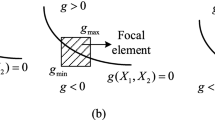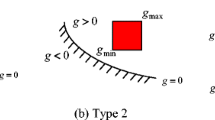Abstract
Evidence theory serves as a powerful tool to deal with epistemic uncertainty which widely exists in the design stages of many complex engineering systems or products. However, the traditional evidence theory model cannot handle parameter correlations that may have profound influences on the reliability analysis results. This paper is supposed to develop a novel evidence theory model with consideration of parameter correlations and its corresponding structural reliability analysis method. First, a multidimensional parallelepiped uncertainty domain which takes into account the influence of parameter correlations is constructed. Second, the corresponding joint basic probability assignments are established for each focal element in the uncertainty domain. Finally, the reliability interval composed of the belief and plausibility measures are computed. Several numerical examples are investigated to demonstrate the effectiveness of the proposed model and the corresponding reliability analysis method.











Similar content being viewed by others
References
Agarwal H, Renaud JE, Preston EL, Padmanabhan D (2004) Uncertainty quantification using evidence theory in multidisciplinary design optimization. Reliab. Eng. Syst. Saf. 85(1–3):281–294
Bae HR, Grandhi RV, Canfield RA (2004a) An approximation approach for uncertainty quantification using evidence theory. Reliab. Eng. Syst. Saf. 86(3):215–225
Bae HR, Grandhi RV, Canfield RA (2004b) Epistemic uncertainty quantification techniques including evidence theory for large-scale structures. Comput Struct 82(13–14):1101–1112
Basir O, Yuan X (2007) Engine fault diagnosis based on multi-sensor information fusion using Dempster–Shafer evidence theory. Inform Fusion 8(4):379–386
Bauer M (1997) Approximation algorithms and decision making in the Dempster-Shafer theory of evidence—an empirical study. Int J Approx Reason 17(2–3):217–237
Ben-Haim Y, Elishakoff I (2013) Convex models of uncertainty in applied mechanics. Elsevier, Amsterdam
Beynon M, Cosker D, Marshall D (2001) An expert system for multi-criteria decision making using Dempster Shafer theory. Expert Syst Appl 20(4):357–367
Cai KY (2012) Introduction to fuzzy reliability. Springer, New York
Dempster AP (1967) Upper and lower probabilities induced by a multivalued mapping. Ann Math Stat 38(2):325–339
Dong W, Shah HC (1987) Vertex method for computing functions of fuzzy variables. Fuzzy Sets Syst 24(1):65–78
Du X (2006) Uncertainty analysis with probability and evidence theories. In ASME 2006 International Design Engineering Technical Conferences and Computers and Information in Engineering Conference, Pennsylvania, USA
Du X, Hu Z (2012) First order reliability method with truncated random variables. J Mech Des 134(9):091005
Eldred MS, Swiler LP, Tang G (2011) Mixed aleatory-epistemic uncertainty quantification with stochastic expansions and optimization-based interval estimation. Reliab. Eng. Syst. Saf. 96(9):1092–1113
Elishakoff I, Haftka R, Fang J (1994) Structural design under bounded uncertainty—optimization with anti-optimizati.n. Comput Struct 53(6):1401–1405
Ferson S, Nelsen RB, Hajagos J, Berleant DJ, Zhang J, Tucker WT, Ginzburg LR, Oberkampf WL (2004) Dependence in probabilistic modeling, Dempster-Shafer theory, and probability bounds analysis. Report No SAND 2004–3072, Sandia National Laboratories
Gogu C, Qiu Y, Segonds S, Bes C (2012) Optimization based algorithms for uncertainty propagation through functions with multidimensional output within evidence theory. J Mech Des 134(10):614–620
Helton JC (2011) Quantification of margins and uncertainties: Conceptual and computational basis. Reliab. Eng. Syst. Saf. 96(9):976–1013
Helton JC, Johnson JD, Oberkampf WL (2004) An exploration of alternative approaches to the representation of uncertainty in model predictions. Reliab. Eng. Syst. Saf. 85(1–3):39–71
Hoffman FO, Hammonds JS (1994) Propagation of uncertainty in risk assessments: the need to distinguish between uncertainty due to lack of knowledge and uncertainty due to variability. Risk Anal 14(5):707–712
Huang Z, Jiang C, Zhang Z, Fang T, Han X (2017a) A decoupling approach for evidence-theory-based reliability design optimization. Struct Multidiscip O 56(3):647–661
Huang Z, Jiang C, Zhou Y, Zheng J, Long X (2017b) Reliability-based design optimization for problems with interval distribution parameters. Struct Multidiscip O 55(2):513–528
Jiang C, Han X, Lu G, Liu ZZ, Bai Y (2011) Correlation analysis of non-probabilistic convex model and corresponding structural reliability technique. Comput Meth Appl M 200(33–36):2528–2546
Jiang C, Wang B, Li ZR, Han X, Yu DJ (2013a) An evidence-theory model considering dependence among parameters and its application in structural reliability analysis. Eng Struct 57:12–22
Jiang C, Zhang Q, Han X, Liu J, Hu D (2015) Multidimensional parallelepiped model—a new type of non-probabilistic convex model for structural uncertainty analysis. Int J Numer Meth Eng 103(16):31–59
Jiang C, Zhang Z, Han X, Liu J (2013b) A novel evidence-theory-based reliability analysis method for structures with epistemic uncertainty. Comput Struct 129:1–12
Kiureghian AD, Ditlevsen O (2009) Aleatory or epistemic? Does it matter? Struct Safe 31(2):105–112
Lee JO, Yang YS, Ruy WS (2002) A comparative study on reliability-index and target-performance-based probabilistic structural design optimization. Comput Struct 80(3–4):257–269
Liu YW, Moses M (1994) A sequential response surface method and its application in the reliability analysis of aircraft structural systems. Struct Safe 16(1–2):39–46
Madsen HO, Krenk S, Lind NC (2006) Methods of structural safety. Dover Publications, New York
Meng D, Zhang H, Huang T (2016) A concurrent reliability optimization procedure in the earlier design phases of complex engineering systems under epistemic uncertainties. Adv Mech Eng. https://doi.org/10.1177/1687814016673976
Morio J (2011) Non-parametric adaptive importance sampling for the probability estimation of a launcher impact position. Reliab. Eng. Syst. Saf. 96(1):178–183
Mourelatos ZP, Zhou J (2005) A design optimization method using evidence theory. J Mech Des 128(4):901–908
Ni B, Jiang C, Han X (2016) An improved multidimensional parallelepiped non-probabilistic model for structural uncertainty analysis. Appl Math Model 40(7–8):4727–4745
Oberkampf WL, Helton JC, Sentz K (2001) Mathematical representation of uncertainty. In 19th AIAA Applied Aerodynamics Conference, CA
Park I, Grandhi RV (2012) Quantification of model-form and parametric uncertainty using evidence theory. Struct Safe 39:44–51
Qiu Z, Wang L (2016) The need for introduction of non-probabilistic interval conceptions into structural analysis and design. Sci China Phys Mech 59:114632
Rao KD, Kushwaha H, Verma AK, Srividya A (2007) Quantification of epistemic and aleatory uncertainties in level-1 probabilistic safety assessment studies. Reliab. Eng. Syst. Saf. 92(7):947–956
Rao SS, Annamdas K (2013) A comparative study of evidence theories in the modeling, analysis, and design of engineering systems. J Mech Des 135(6):061006
Riley ME (2015) Evidence-based quantification of uncertainties induced via simulation-based modeling. Reliab. Eng. Syst. Saf. 133:79–86
Shafer G (1976) A mathematical theory of evidence. Princeton University Press, New Jersey
Shah H, Hosder S, Winter T (2015) Quantification of margins and mixed uncertainties using evidence theory and stochastic expansions. Reliab. Eng. Syst. Saf. 138:59–72
Sobczyk K, Trcebicki J (1999) Approximate probability distributions for stochastic systems: maximum entropy method. Comput Method Appl M 168(1–4):91–111
Srivastava RK, Deb K, Tulshyan R (2013) An evolutionary algorithm based approach to design optimization using evidence theory. J Mech Des 135:081003
Tang H, Li D, Chen W, Xue S (2016) Uncertainty quantification using evidence theory in concrete fatigue damage prognosis. In IEEE International Conference on Prognostics and Health Management (ICPHM), Ottawa
Tang H, Li D, Li J, Xue S (2017) Epistemic uncertainty quantification in metal fatigue crack growth analysis using evidence theory. Int J Fatigue 99:163–174
Wang L, Wang X, Xia Y (2014) Hybrid reliability analysis of structures with multi-source uncertainties. Acta Mech 225:413–430
Wang L, Wang X, Su H, Lin G (2017) Reliability estimation of fatigue crack growth prediction via limited measured data. Int J Mech Sci 121:44–57
Wang Z, Huang HZ, Li Y, Pang Y, Xiao NC (2012) An approach to system reliability analysis with fuzzy random variables. Mech Mach Theory 52:35–46
Warren-Hicks W, Hart A (2010) Application of Uncertainty Analysis to Ecological Risks of Pesticides. CRC Press, Florida
Yager R, Fedrizzi M, Kacprzyk J (1994) Advances in the Dempster-Shafer theory of evidence. John Wiley & Sons, New York
Yang X, Liu Y, Gao Y (2016) Unified reliability analysis by active learning Kriging model combining with random-set based Monte Carlo simulation method. Int J Numer Meth Eng 108(11):1343–1361
Yao W, Chen X, Ouyang Q, Tooren MV (2013) A reliability-based multidisciplinary design optimization procedure based on combined probability and evidence theory. Struct Multidiscip O 48(2):339–354
Yin S, Yu D, Yin H, Xia B (2017) A new evidence-theory-based method for response analysis of acoustic system with epistemic uncertainty by using Jacobi expansion. Comput Method Appl M 322:419–440
Yu X, Chang KH, Choi KK (1998) Probabilistic structural durability prediction. AIAA J 36(4):628–637
Zadeh LA (1978) Fuzzy sets as a basis for a theory of possibility. Fuzzy Sets Syst 1(1):3–28
Zhang Z, Jiang C, Wang GG, Han X (2015) First and second order approximate reliability analysis methods using evidence theory. Reliab. Eng. Syst. Saf. 137:40–49
Acknowledgements
This work is supported by the National Natural Science Foundation of China for Distinguished Young Scholars (Grant No. 51725502), National Natural Science Foundation of China (Grant No. 51490662), National Key Research and Development Plan (Grant No. 2016YFD0701105), National Natural Science Foundation of China (Grant No. 11402296).
Author information
Authors and Affiliations
Corresponding author
Rights and permissions
About this article
Cite this article
Zhang, Z., Jiang, C., Ruan, X.X. et al. A novel evidence theory model dealing with correlated variables and the corresponding structural reliability analysis method. Struct Multidisc Optim 57, 1749–1764 (2018). https://doi.org/10.1007/s00158-017-1843-9
Received:
Revised:
Accepted:
Published:
Issue Date:
DOI: https://doi.org/10.1007/s00158-017-1843-9




